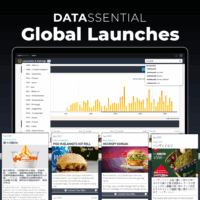Clean customer relationship management (CRM) data isn’t a back-office checkbox anymore. It’s the foundation of every high-performing sales organization in foodservice, and the gap between teams that maintain it and teams that don’t is widening fast. In our recent webinar, Data Enrichment: Transform CRM Clutter into Clear Pipelines, we walked through the mechanics of data cleanup, matching, and integration. Below is a deeper look into what every ideal customer profile should look like when it’s built on enriched operator intelligence, and how suppliers across categories can use that foundation to identify whitespace, accelerate pipelines, and stop wasting time on leads that aren’t going to close.
Watch the full webinar here.
The Real Problem with Most Customer Profiles
Most foodservice suppliers can describe their ICP in broad strokes. “Mid-sized chains.” “Fast casuals with alcohol.” “Independents doing $2M+.” But when you ask how they keep their pipeline (or target lists) up-to-date in a market where 1.5% of all restaurant locations change every month, the answer usually involves spreadsheets, guesswork, and a database that hasn’t been scrubbed in quarters.
The issue isn’t that teams don’t understand who they want to sell to. It’s that their customer profile definitions can’t keep pace with how fast the industry moves. Restaurants don’t stay static. They rebrand. They expand into new dayparts. They flip from corporate to franchise ownership. They add delivery platforms, upgrade point-of-sale systems, change menus, or close entirely. A chain that fit your target profile perfectly six months ago might have been acquired, restructured, or pivoted into a completely different segment by now. And if you’re not analyzing your current customer base, you have no data to help you understand what your best customers have in common or how to strategically target your highest-potential leads.
Without ongoing data enrichment, your ideal customer profile becomes a historical artifact rather than a living filter. You’re prospecting based on who operators used to be, not who they are today. And that disconnect shows up everywhere: in conversion rates that plateau, in pipeline forecasts that miss, in reps spending half their day researching accounts that should have been disqualified weeks ago.
The teams winning right now aren’t just defining their ideal customer profile. They’re feeding it with standardized operator names, active-status verification, chain-system mapping, franchise flags, cuisine identifiers, segment classifications, popularity scores, review trends, tech stack data, and purchase potential signals. They’re pressure-testing their assumptions against real operator behavior every month. They’re segmenting by performance, not just profile. And they’re using enriched attributes to distinguish a rising independent from a declining chain, a franchise ready to modernize from one locked into legacy contracts, a fast-growing limited-service restaurant from one barely hanging on.
Strong customer profiles aren’t built from persona decks. They’re built from living, breathing, constantly refreshed data.
What a Healthy Customer Profile Should Accomplish
A truly functional ideal customer profile does three things exceptionally well, and enriched data is what makes all three possible.
It should dramatically shrink your addressable universe.
If your target profile leaves you with a list of 60,000 “potential customers,” it’s not doing its job. The goal isn’t to cast the widest net. It’s to focus sales effort on the operators most likely to convert, expand, and stay. CRM data enrichment makes that possible by stripping away the noise: the “doing business as” names that aren’t actual restaurants, the real-estate holding companies, the inactive units, the legal entities that will never make a purchase decision, the micro-independents that don’t align with your contract minimums, the chains whose procurement structure makes them functionally unreachable. Automated matching and standardization eliminate the clutter, so your reps aren’t burning time on leads that were never real opportunities in the first place. Datassential’s operator database and identity resolution capabilities are designed to do exactly that work at scale: cleaning, de-duplicating, and classifying foodservice locations so sales and marketing teams start from a precise, actionable universe instead of a messy list.
It should surface whitespace you didn’t know existed.
This is where enriched attributes become strategic gold. When you layer segment, cuisine, chain size, franchise structure, tenure, popularity score, and tech stack together, patterns emerge that gut instinct alone would never catch. You start seeing the limited-service restaurants that over-index in your category. The early-stage chains that behave exactly like your best customers did at the same growth phase. The regional brands expanding fastest in your strongest markets. The franchise groups that just took on new territory and are actively modernizing their supplier base. The independents whose review velocity and popularity trends signal they’re about to scale. Clean, enriched data doesn’t just validate your existing profile. It shows you the segments, geographies, and operator types you should have been targeting all along. With Datassential’s depth of operator attributes and menu, concept, and trend data, those signals become visible and quantifiable instead of anecdotal, turning whitespace analysis into a repeatable go-to-market motion.
It should guide your timing, not just your targeting.
One of the most underutilized dimensions of data enrichment is knowing when an operator is primed for outreach. Tenure matters. A brand-new restaurant is focused on survival, not system upgrades. But a two-year-old limited-service restaurant that’s gaining Google review traction and seeing visit growth? That’s an operator ready to invest in equipment, ingredients, or technology that can help them scale. A recently acquired regional chain signals consolidation and potential system modernization. A fast-casual concept launching breakfast or adding alcohol service is signaling menu expansion and new supplier needs.
Chain size, years in business, popularity trends, and operational changes all tell you not just who to prospect, but when they’re most likely to engage. Good customer profiles don’t just answer “who should we chase?” They answer “when are they ready to buy?” Datassential’s operator, menu, and consumer behavior insights give commercial teams those timing cues in advance, so outreach can be sequenced around real market signals instead of generic cadences.
Turning Your Profile into a Lead Scoring Engine
Once your ideal customer profile is built on enriched data, the next step is embedding it directly into your customer relationship management system as an automated lead scoring model. This is where data personalization transforms from a buzzword into a workflow.
Instead of relying on reps to manually qualify leads using gut instinct or outdated field notes, you create a scoring algorithm based on the attributes that predict success for your business. For one supplier, that might be: limited-service restaurant segment, 10–50 units, franchise structure, opened in the last three years, serves alcohol, popularity score trending upward. For another, it might be: full-service independent, $2 million-plus estimated revenue, chef-driven cuisine, tech-forward point-of-sale system, strong review ratings. The specifics vary by category, but the principle is the same. You’re turning your ideal customer profile into a repeatable, scalable formula that automatically prioritizes the operators most likely to convert.
The key is validation. Top-performing teams don’t just build a scoring model and hope it works. They check it against real deal history. They compare high-scoring leads to actual closed-won accounts. They adjust weights until the model mirrors reality. They test it against their pipeline and ask: are the operators scoring highest actually the ones converting fastest? Are we seeing patterns we missed before? Are there attributes we overvalued or undervalued?
When lead scoring is built on enriched data and continuously refined, it stops being a theoretical exercise and becomes a monthly prioritization engine. Reps know exactly which operators deserve immediate attention. Sales development representatives can focus their outbound on accounts that match proven success patterns. Revenue operations teams can trust the funnel metrics because the ideal customer profile isn’t a vague recommendation—it’s embedded logic running in the background of every workflow. Leadership gets cleaner forecasts because pipeline quality is no longer subjective. And marketing can build campaigns around the segments, cuisines, and operator types that actually drive revenue, rather than guessing based on outdated personas.
Enrichment Solves the Whitespace Problem
One of the most powerful use cases for CRM data enrichment is whitespace analysis, and it’s something most suppliers completely underutilize.
Whitespace isn’t just “operators we haven’t reached yet.” It’s the gap between where you’re selling today and where your best opportunities actually exist. It’s the segments you’re underweight in. The geographies where you’re leaving revenue on the table. The chain sizes or franchise structures that over-index in your category but don’t show up in your pipeline. The cuisines or dayparts where your product fits perfectly, but you’ve never built a targeted campaign.
Without enriched data, whitespace analysis is guesswork. You might notice you’re not closing many pizza chains, but you don’t know if that’s because you’re not targeting them, because they’re not a fit, or because your outreach isn’t resonating. With enriched data, you can see exactly where the opportunity gaps are. You can filter your entire addressable market by the attributes that matter—segment, cuisine, chain size, franchise versus corporate, years in business, popularity score, tech stack, purchase potential—and compare that universe to your current customer base. The delta between the two is your whitespace.
Let’s say you’re an equipment supplier and you realize that 40% of your revenue comes from limited-service restaurants with 10–50 units, but those operators only represent 15% of your active pipeline. That’s a signal. You’re closing them at a high rate when you reach them, but you’re not reaching enough of them. Enriched data lets you build a target list of every limited-service restaurant in that size range, filter by region, prioritize by popularity and tenure, and hand your reps a whitespace roadmap that’s based on real market composition, not intuition.
Or maybe you’re a beverage distributor and you notice you have almost no penetration in full-service independents with chef-driven menus, even though that segment is growing faster than any other in your region. Enrichment lets you identify those operators, score them based on fit, and build a campaign specifically designed for that whitespace. You’re not just filling the pipeline. You’re filling it with the right operators at the right time.
 EN | English UK
EN | English UK DE | Deutsch
DE | Deutsch FR | Français
FR | Français IT | Italiano
IT | Italiano SP | Español
SP | Español





